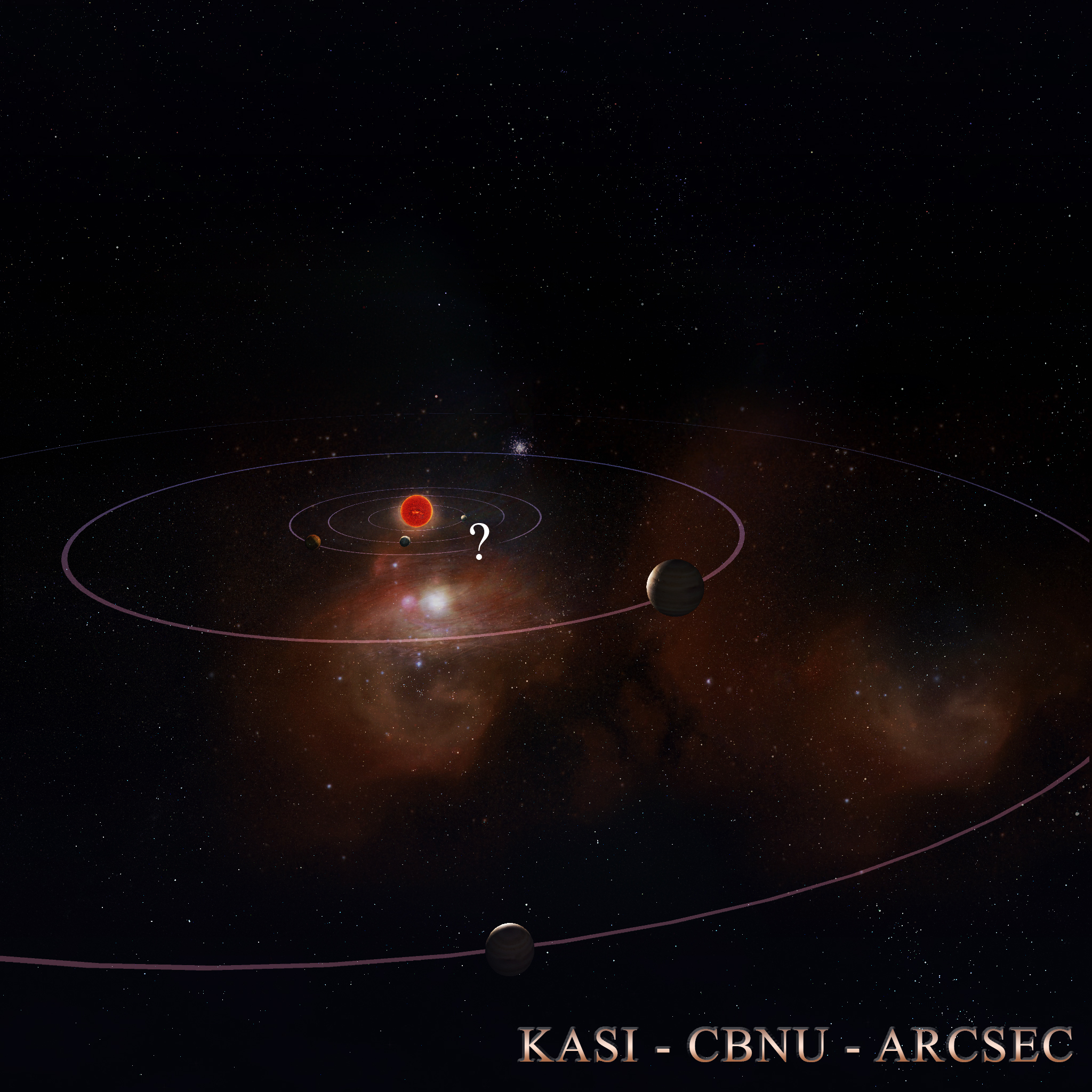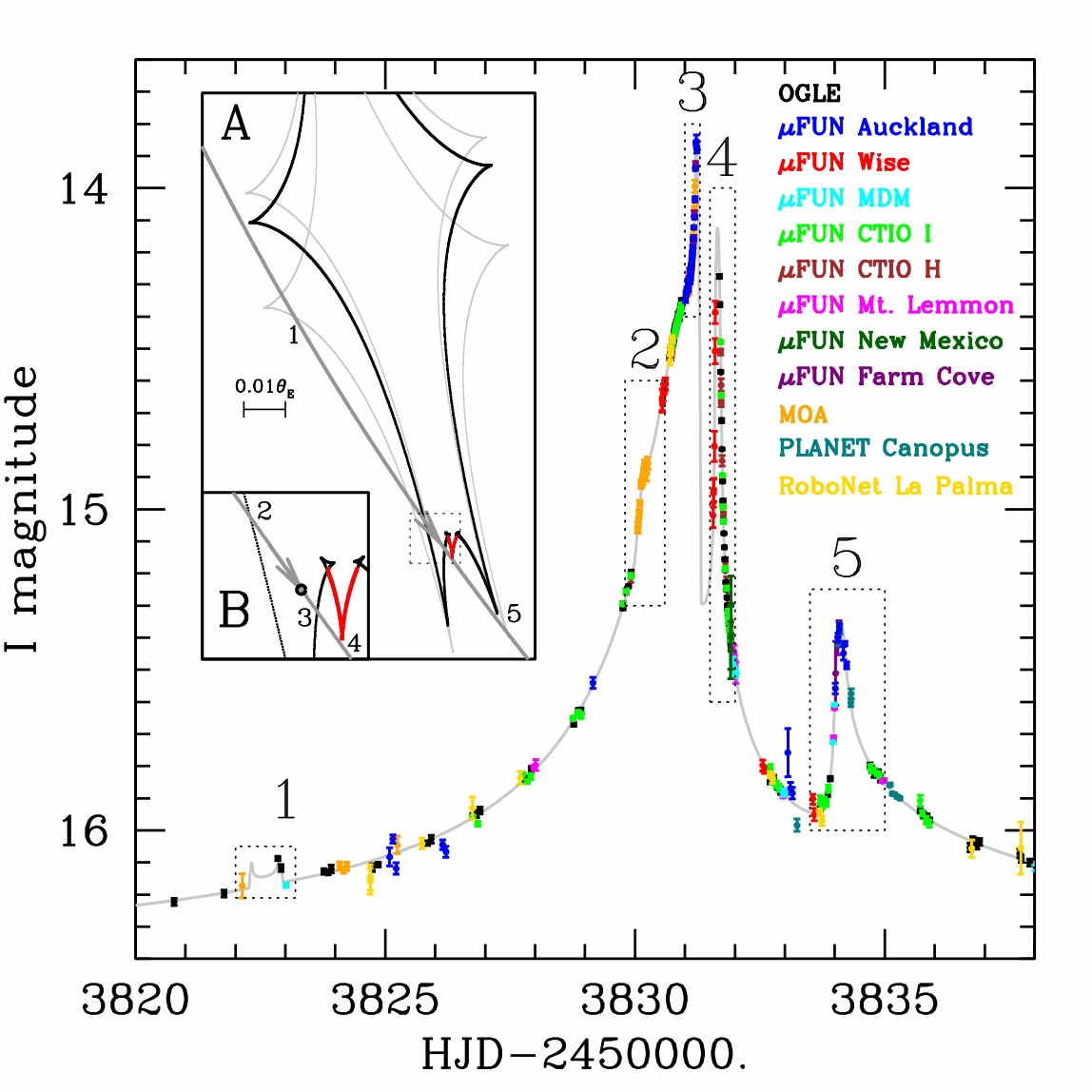

While planet OGLE-2006-BLG-109Lb with 0.71 Jupiter masses is 2.3 times as far from its host star as the Earth is from the Sun, the less massive OGLE-2006-BLG-190Lc, 0.27 times the mass of Jupiter, resides at twice the distance from its host star as his fellow companion.
Apart from the fact that their host star is only half as massive as the Sun, and therefore cooler, the OGLE-2006-BLG-109L planetary system otherwise bears a remarkable similarity to the Solar system. Both the ratio between the two masses of the detected giant planets (close to 3:1) and the ratio between their orbital radii (1:2) are remarkably similar to those of Jupiter and Saturn. Similarly, the ratio between the orbital periods of 5 years and 14 years, respectively, resembles that between Jupiter and Saturn (2:5).
Previous observations have shown that not more than 10 per cent of stars appear to host planets with masses and orbits which current planet searches are sensitive to, and the latter reveal their existence by means of a microlensing signature only with a characteristic probability. Our double catch around OGLE-2006-BLG-109L therefore suggests that lonesome gas-giant planets are the exception and planetary systems are the rule.
The gravitational microlensing technique provides a peerless opportunity to study extra-solar planets that resemble the gas giants of the Solar system at their respective orbital radii, given that one does not need to wait for many years for them to complete their orbit. In contrast, the lack of detection efficiency to such objects by other techniques, which dominate the current number count of the New Worlds Atlas (NASA/JPL PlanetQuest), appears to account for the fact that so far only a bit more than 10 per cent of the stars with known planets have been found to host planetary systems.
| OGLE-2006-BLG-109L | OGLE-2006-BLG-109Lb | OGLE-2006-BLG-109Lc | Sun | Jupiter | Saturn | ||
|---|---|---|---|---|---|---|---|
| coordinates | (RA, Dec) | (17h52m34.51s, -30:05:16.0) | — | — | varies | — | — |
| distance from observer | DL | (1.49 ± 0.13) kpc (4860 ± 420) lyr | — | — | 1 AU | — | — |
| mass | M | (0.50 ± 0.05) Msun | (0.71 ± 0.08) Mjup | (0.27 ± 0.03) Mjup | 1 Msun | 1 Mjup | 0.30 Mjup |
| orbital radius | a | — | (2.3 ± 0.2) AU | (4.6 ± 0.5) AU | — | 5.2 AU | 9.6 AU |
| orbital period | P | — | (4.9 ± 0.4) yr | (14.0 ± 1.5) yr | — | 11.9 yr | 29.7 yr |
| effective temperature | Teff | ~ 4000 K ~ 3700 °C | (82 ± 12) K (-191 ± 12) °C | (59 ± 7) K (-214 ± 12) °C | 5780 K 5510 °C | 112 K -161 °C | 95 K -178 °C |
While the lack of respective signatures rules out any further planets of more than Saturn mass closer to the host star down to the separation of Venus from the Sun, there is well the opportunity for terrestrial planets (like Mercury, Venus, Earth, or Mars) to reside there. Moreover, planets taking the roles of Uranus and Neptune, respectively, could also be present. These features make the OGLE-2006-BLG-109L system the most similar to the Solar system amongst the about 25 exo-planetary systems discovered so far.

Since the first discovery of a planet orbiting a star other than the Sun, namely 51 Peg b, the New Worlds Atlas (NASA/JPL PlanetQuest) has grown within a bit more than a decade to include about 270 extra-solar planets, and roughly 25 stars are now known to be orbited by more than a single planet. The recent years have seen the detection of planets that resemble the Earth more and more closely, and now we also see planetary systems being found that bear striking similarities with the Solar system. However, we have to keep in mind that about 100 billion stars populate the Milky Way, which itself is just one of at least 100 billion galaxies in the Universe. Given that, at least for the Milky Way, we know that at least few percent of stars do host planets, we have so far only probed an extremely tiny bit. We should therefore avoid the temptation to overstress the relevance of specific exo-planetary systems - any of them is just one out of huge number that can be expected to be out there. And the Solar system with Earth in it is just one, too.
However, the microlensing technique is well suited to infer a census
of planets within the Milky Way. Once we know that planets similar
to Earth in systems similar to the Solar system are common (which first
hints already suggest), it is straightforward to go ahead with finding
them and investigating whether these harbour any forms of life.
A widely accepted paradigm of planet-formation theories is that planet formation is boosted once far enough distances from the host star are reached, so that low enough temperatures allow hydrogen compounds such as water, ammonia, and methane to condense into solid ice grains. This substantially increases the number of available cores onto which further material can be accreted. The corresponding 'snow line' that marks this transition is thought to separate the giant planets of the Solar system (Jupiter, Saturn, Uranus, Neptune) from the terrestrial ones (Mercury, Venus, Earth, Mars). A quite simplified model of planet formation would see the most massive giant planet to form not far outside the snow line, and the mass of futher planets to decrease with distance from their host star. In fact, the Solar system roughly matches such a scenario.
Given that the equilibrium temparatures of OGLE-2006-BLG-109Lb and OGLE-2006-BLG-109Lc are about 30 per cent lower than those of Jupiter and Saturn, respectively, one might wonder whether there might be another more massive planet in a closer orbit. However, the lack of respective signatures rules out any potential further planets of Saturn mass or more closer to the host star for orbital radii exceeding that of Venus, leaving the opportunity for terrestrial planets to reside there. Moreover, planets taking the roles of Uranus and Neptune, respectively, could also be present in the OGLE-2006-BLG-109L system. Most of the known planetary systems around stars other than the Sun contain close-in gas-giant planets at orbital radii where we find the terrestrial planets of the Solar system, which are believed to have migrated into their current orbit after having formed further apart. Other cases show increasing planet masses with distance from their host star. It turns out that one is left with OGLE-2006-BLG-109L as the only firmly established system so far that matches vital characteristics of the Solar system, although there have been suggestions for less massive second outer gas-giant planets to orbit 47 UMa and 14 Her, respectively.
On 26 March 2006, the OGLE team, led by Prof Andrzej Udalski from Warsaw University, reported by means of their Early-Warning System (EWS) their 109th event towards the Galactic bulge in that year, systematically named OGLE-2006-BLG-109. Two days later, on 28 March, they found an unexpected brightening of this event by about 10 per cent, which could have been the signature of a planetary companion to the lens star. In fact, it was such a signal that led to the detection of OGLE-2005-BLG-390Lb, with a mass about five times that of Earth the most Earth-like extra-solar planet at the time of its discovery.
This exciting news from OGLE did not remain unheard, and other teams working in the field of gravitational microlensing started follow-up observations on OGLE-2006-BLG-106. For the UK-based RoboNet microlensing programme, led by Prof Keith Horne from the University of St Andrews, Dr Martin Dominik, Royal Society University Research Fellow at the same institution, devised a sampling strategy and passed it on to Dr Martin Burgdorf, the RoboNet project scientist at the Astrophysics Research Institute (ARI) of Liverpool John Moores University (LJMU), who entered the respective observing requests into the scheduler.
On 5 April the event underwent a deviation from the single-lens form indicative of a binary lens. Within 12 hours of this deviation, Dr Scott Gaudi, from Ohio State University, the lead author of the publication and member of the MicroFUN team, found that a preliminary model indicated a Jovian-class planet, which he predicted to generate an additional peak on 8 April. This peak turned out to occur, manifesting the discovery of OGLE-2006-BLG-109Lc with a mass close to that of Saturn. However, the morning after Dr Gaudi made the prediction, he woke up with data that surprisingly showed an additional peak on 5-6 April, which later turned out to be the signature of a further Jovian-class planet, namely OGLE-2006-BLG-109Lb, more massive than OGLE-2006-BLG-109Lc and orbiting closer to their host star.


For OGLE-2005-BLG-390Lb, only probability densities for its properties could have been derived from the likelihood that a specific choice led to the determined model parameters as well as a kinematic model of the Milky Way and a mass function of the lens star. In contrast, the model parameters themselves (along with their uncertainties), define the properties of OGLE-2006-BLG-109Lb and OGLE-2006-BLG-109Lc. This became possible with not only the finite angular size of the source star, but also the acceleration of the Earth's orbit having detectable effects on the observed light curve. With OGLE-2006-BLG-109Lc being probed by characteristic features over a time span of more than 2 weeks, the two components of its proper motion relative to its host star can be measured. Assuming that it is circular, its orbit can thereby be completely determined, except for a two-fold ambiguity, where the values listed above for the (three-dimensional) orbital radiii correspond to the stochastically favoured solution. While the inclination of the orbit of OGLE-2006-BLG-109Lc follows from the measured proper motion vector and other model parameters, a coplanar orbit has been assumed for OGLE-2006-BLG-109Lb.